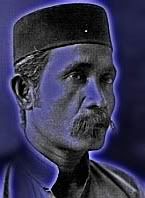A Great Shame
I have received in my mailbox, a stirring description of bbalöh in Kampong Kolang within the borders of Dewang Bandörang Kuala Trengganu (before it became a city). There was a tall tamarind tree there (with ghosts, some say, dangling from branches), and there used to be an old istana at the bend in the roadway. There was the house of Mr Isaacs almost opposite the tamarind tree (he was the founder of the Grammar School on the hill), and next door to him, going towards the masjid, was the finely carved old Malay house of my friend Hashim Pök Long whose father (Pök Long) made ma’ajong tupai melompat (the jumping squirrel herbal paste for men); and deep in the interior of Kampong Kolang was a vast old cemetery that stretched all the way to the Malay School of Paya Bunga. Nobody seemed to have any memory of who was first buried there, nor when the last person was interred. Kampong Kolang seemed to have had two names, the other one was Kampong Petani and this may have connections with the group of Patani people who came down with the first Sultan of the present ruling house of Trengganu.
The Abraham family lived in Kampong Kolang, next door to the house of Hashim Pök Long, and their daughter Elizabeth was my classmate in school; and further down the road, still on the same side, was the house of the Paul family, two of whose daughters came to my book-signing at the MPH in Mega Mall last January. In Penang I met another one of the Paul sisters, and she touched me greatly by her display of a small Trengganu flag on her gatepost. And further still down the road, at the junction with Jalan Paya Bunga, once stood the house of the family of Sayyids, but in Trengganu the head of the family was known simply as Che Mat Riau. They were Kolamers all.
Reading what I wrote on bbalöh, my old Kolamer friend Ajidoel wrote in graphic detail the piece below that shatters somewhat my picture of Kolang as a placid place:
“[A]mbe teringat kepade satu kejadian di Kolang ketike zaman awal remaje dulu. Ade dua orang ppuang mude ‘bbalöh’ dan akhirnye ‘beggöcöh’. Wui! Dahsat, dahsat! Tadak sape yang berani meleraikan pergaduhan itu. Masing2 tengok saje je! Free show laa kate kan! Macam kucing ggömöl je , wa-wa , kerekar- mengkerekar , senjöh rambut, ggigit- menggigit , gguling-bating , baddi kerekoh, telanjang bulat … hei huddoh kejenis !! Akhirnye, orang ppakat simböh air kepade mereka … dan barulah mereke berhenti beggömöl . Döh nök buat ape lagi … Mereke pun ternyate baru seddör dari ‘rrasok’ iblis gamöknye. ‘Aib! ‘Aib ! Pahtu, mereke pun tergese2 mencari dan mmakai semula kain yang sudöh koyak-rabak . Hai, besar sunggoh keamaluang mereka tu !!”“I remember an incident in Kolang in the early days of my youth. Two young women were involved in an argument that finally ended in their exchanging blows. Wow! It was really bad! People just looked on without daring to do anything! And what more, it was a free show! They were like cats in a scrap, two noisy, scratching, hair-pulling females trying to sink their teeth into each other until they were both starkers … what a horrible sight!! Finally the onlookers decided to douse their heat with water … and only then did they stop grappling. What was there left for them to do… Having been brought back to their senses they realised that they'd probably been possessed by the devil. It was shameful, shameful! They hastily retrieved their sarongs to put them back on, but the sarongs were then in tatters. Oh my, how big was their shame!!”
I suspect that Ajidoel may have inserted a wicked pun in that last note of shame. The word kemaluang [stdspk., kemaluan] is rooted in the word malu, which means ‘shame’. In another sense, kemaluan also means “that which causes shame”, a sense that I can only explain through the Latin pudere [“be ashamed”] that you will probably have met through its derivate ‘pudendum’.
Labels: Abraham, Isaacs, Kampong Kolam, Kampong Petani, kemaluan, Patani, Paul family, pudendum


